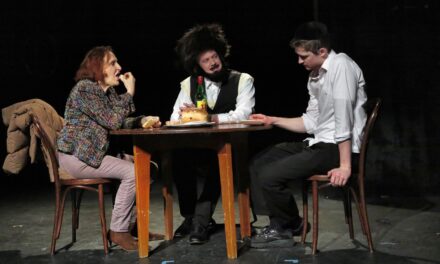
by Samuel L. Leiter
Tickets are reportedly scarce but here are three reasons why you should nonetheless try your damnedest to see The Damned, Dutch director Ivo van Hove’s startling stage version of Italian director Luchino Visconti’s 1969 film of that name: 1) a script of powerful social, political, and emotional relevance; 2) an awesomely magnetic, physically stunning, and occasionally shocking production; and 3) an exceptional acting ensemble drawn from the ranks of France’s foremost classical company, the Comédie Française. (Projected surtitles offer simultaneous translations of the French script.) Presented within the cavernous confines of the Park Avenue Armory, itself worthy of a visit, The Damned is a unique event you’ll remember for years.
Love him or loathe him (I loved his The Crucible, loathed his Scenes from a Marriage), van Hove again demonstrates why he’s among the most controversial experimental directors on the international scene. For The Damned, first seen at the Avignon Festival in 2016, he’s again collaborated with his partner, set and lighting designer Jan Versweyveld. Instead of replicating Visconti’s film, which van Hove says he’s avoided seeing, they’ve created a theatrical equivalent to the film script, which Visconti wrote with Nicola Badalucco and Enrico Medioli. Thus famous moments, as when a character performs à la Marlene Dietrich in The Blue Angel, are nothing like their originals.
The Damned is the epic drama of the Essenbeck family, a German family of Krupp-like steelwork and arms manufacturers, showing them—between 1933-1934—struggling to maintain the powerful firm’s position while accommodating the demands of the newly empowered Hitler and the Nazis. Even the Roy family of TV’s Succession, with its vipers’ nest of ambitious heirs to their ruthless, billionaire father’s business domain, pales by comparison. The Essenbecks’ behavior, paired with the extreme depravity of the Nazis, offers an excoriating picture of the maggoty world from which World War II and the Holocaust were born. Be prepared to be discomfited.


A cast of 13 principals, three children, and six “Men in Black,” who serve multiple purposes, enact this tale beginning with the downfall of the patriarch, Baron Joachim von Essenbeck (Didier Sandre), who despises the Nazis but reluctantly agrees to cooperate with them; it’s during his birthday party that the Reichstag burns down.
What follows is a complex web of power plays as the players abandon their morality in the name of self-interest. Among them are Joachim’s son, Konstantin (Denys Podalydés), a brownshirt in the paramilitary SA, rivals of the SS, represented by the cruelly cunning cousin, Wolf von Aschenbach (Eric Génovèse). Then there’s Sophie (Elsa Lepoivre), the cobra-like widow of Joachim’s son, and mother of the ambisexual, pedophiliac, Oedipally-conflicted Martin (Christophe Montenez).
Sophie (who comes to one of the most ignominious ends I’ve ever seen on a stage) is the lover of Friedrich Bruckmann (Guillaume Gallienne), who rises to power with her support. Among the benign personages suffering tragic consequences (Dachau plays its part) are Joachim’s daughter, Elisabeth (Adeline d’Hermy), and her anti-Nazi husband, Herbert Thallman (Löic Corbery).


The episodic play, accompanied by Eric Sleichem’s haunting score inspired by German baroque music, sprawls across a huge, red, wooden platform (suggesting fire), with a large dining table at one side, rows of makeup tables at the other, and bleachers for actors to sit on when offstage. Racks of costumes are visible, a miniature arrangement of what seem like metal steam pipes loudly blast clouds of steam, and a large LED projection screen overlooks everything. Much of the staging has a ritualistic quality, as when the company periodically assembles in prearranged tableaux.
The most memorable device is that screen’s use for projections, some archival, but mostly of the actors, whose scenes (in keeping with Tal Yarden’s video design) are tracked by cameramen so we see both the live action and its close-up images. Early on this creates problems of focus; eventually, you may find yourself watching the videos more than the live action.
The videos are often horrific, as when deceased characters are placed in coffins, where they awake when the lids are closed and suffer miserably before they ultimately succumb. Some show creepy views of Martin molesting a young girl (the kid actors in this play are getting an unorthodox education), or seductive scenes of hands on others’ receptive genitals, or, the coup de grâce, an astonishing take on the Night of the Long Knives as an all-male, nude orgy, shot from overhead, that ends in a virtual bloodbath.


This last scene, which brings to mind the slaughters carried out in recent years in the name of ideology, is only one of the ways in which The Damned underlines world problems. The rise of right-wing populism, even proto-fascism, the increasingly cozy relationships of big business with government agencies, censorship and the suppression of free speech, and so on, all run through your head as you watch.
If great theatre is what gets your heart and soul moving without letting up for two hours and 10 intermission-less minutes, and haunts you through the night that follows, The Damned is great theatre, or pretty close to it.
The Damned. Through July 28 at the Park Avenue Armory (642 Park Avenue, between 66th and 67th Streets). www.armoryonpark.org
Photos: Stephanie Berger






















